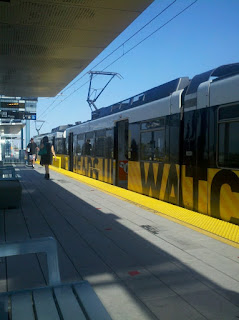Los Angeles has a good light rail system. It is currently undergoing expansion to extend to Santa Monica and there are more expansions planned for the near future. It doesn't connect every area of the city, but you can move reasonably efficiently between major hubs for less than $5 a day. Depending on traffic, it can be faster than driving.
 |
| Above ground light rail (Culver City Station) |
 |
| LA subway (Universal City Station) |
I haven't used the bus system extensively. In fact, we've primarily used the Culver City bus since it connects several areas near our apartment. It is pretty typical for a bus system in that it is slow since it can stop at nearly every intersection. However, they run frequently enough to make them viable. We often use the bus to go to dinner on Friday night just so we don't have to drive or find parking.
A few tips if you are new to area (or just now weaning yourself off of a car):
- Get a TAP card. These store money or passes and work on all light rail, LA buses, Culver City buses, and a handful of other adjacent city buses.
- You can take your bike on the train and most buses have the bike racks in front. Select rail stations (usually the park and ride ones) have bike lockers that can be rented for $48 a year. Having recently had my bike stolen from a station bike rack, I'd recommend springing for one or taking your bike with you in the train and locking it up near your office.
- Get the Los AngelBus app (free!) if you will be taking the bus (sadly only covers LA city buses, though). It tracks buses using GPS so you know where your bus is. It also shows stops with route and bus numbers and gives you a time estimate of when the next several buses will arrive.
- I've traveled alone on LA public transport and never felt unsafe. That being said, use street sense and keep your possessions in hand, don't bring out expensive electronic gadgets, and don't travel alone late at night. Most snatch and grabs seem to take place on station platforms, so leave your cell phone/iPad put away until you get on the train (most people use them once seated on the train).
Public transportation in Los Angeles gets a thumbs up from me! If you are coming here as a tourist you can definitely benefit from a more relaxing experience by going car free. Light rail links you from the airport or Union Station to Pasadena (Rose Bowl), Universal City (Universal Studios Hollywood), Hollywood theaters, downtown, MacArthur park, Expo Park (California Science Center w/ space shuttle, Natural History museum, USC), Long Beach (Queen Mary, aquarium, beach, Grand Prix), Culver City (Sony Studios), and many more wonderful and off the beaten path places!



